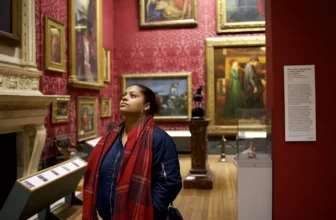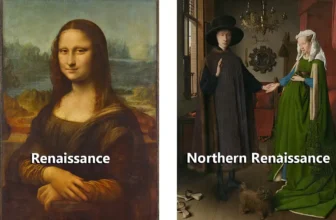Meaning of John the Baptist in the Wilderness Painting
In the gentle hush of a forest clearing, the figure of a lone man sits in pensive solitude. Draped in a humble camel-hair garment, he rests beneath the shadow of a tree, head bowed, hands joined in prayer, a lamb quietly nestled beside him. This serene yet stirring image is captured in John the Baptist in the Wilderness, a masterpiece by the 15th-century Dutch painter Geertgen tot Sint Jans. At first glance, it is a tranquil portrait of a hermit in nature. But as we delve deeper, this painting reveals a world of theological symbolism, emotional resonance, and the spiritual fervor of a bygone era.
Who Was Geertgen tot Sint Jans?
To understand the painting, we must first understand the artist. Geertgen tot Sint Jans, meaning “little Gerard of Saint John’s,” was active in the Northern Netherlands during the latter part of the 15th century, roughly from 1465 to 1495. Although his life remains shrouded in mystery, art historians believe he lived and worked in Haarlem and was associated with the Order of Saint John, also known as the Knights Hospitaller, serving perhaps as a lay brother or a commissioned painter for the order.
Geertgen’s oeuvre, while limited in number, is recognized for its spiritual intensity, meticulous detail, and innovative compositions. His style bridges the elegance of Early Netherlandish painting, best exemplified by Jan van Eyck and Rogier van der Weyden, with a softer, more intimate emotional tone. Geertgen’s ability to communicate profound theological themes with a tender human touch made him a beloved figure in Northern Renaissance art.
The Painting Overview
John the Baptist in the Wilderness is thought to have been painted around 1485–1490 and is now housed in the Gemäldegalerie in Berlin. The panel is modest in size, measuring approximately 28 by 20 inches, but it contains a wealth of narrative and symbolism that belies its dimensions.
The central figure, Saint John the Baptist, is seated contemplatively on a rock in the midst of a forest landscape. He is clad in his iconic camel-hair robe, a reference to the biblical description found in the Gospels. At his side lies the Lamb of God (Agnus Dei), a direct symbol of Christ, alluding to John’s declaration in the Gospel of John: “Behold, the Lamb of God, who takes away the sin of the world” (John 1:29). In his hand, John holds a cross-shaped staff, inscribed with the same Latin phrase: “Ecce Agnus Dei.”
Behind him unfolds a vivid landscape, lush trees, winding paths, distant hills, and a meandering river, evoking not only the natural world but also the passage of time and spiritual journey. A small group of people can be seen traveling toward a distant city, perhaps Jerusalem or a generalized symbol of spiritual society. The wilderness is not barren or harsh but Edenic, serene, and fertile, a marked contrast to the arid desert often associated with John’s ministry.
The Painting as Devotional Art
This artwork is a quintessential example of devotional art from the Northern Renaissance. It was not created for public display in a grand church or civic hall, but likely for private contemplation, either in a monastery or the home of a devout patron. The viewer is invited to sit with John, to enter his world of prayer, sacrifice, and prophetic vision.
The calm, almost meditative mood of the painting draws the viewer into a shared silence with the saint. There is no drama, no overt miracle or martyrdom, only the intimate stillness of a man waiting for God’s call. This quietude would have deeply resonated with 15th-century viewers who sought personal, mystical communion with the divine in a time of religious fervor, monastic renewal, and the rise of affective piety.
Theological and Symbolic Significance
At the core of this painting lies a dense web of symbolism, all pointing to John’s role as the forerunner of Christ.
The Lamb: Arguably the most significant symbol, the lamb represents Jesus Christ. Its docile presence at John’s feet is a poignant reminder of the Passion to come. The lamb is both a pastoral companion and a sacrificial foreshadowing.
The Cross-Staff: Held gently but firmly by John, the staff resembles a reed cross, referencing both his baptismal ministry and the Passion of Christ. Its banner reads Ecce Agnus Dei, visually linking John’s identity to his prophetic utterance.
The Wilderness: Biblically, the wilderness is a place of testing, revelation, and transformation. Here, it is portrayed not as desolation, but as divine retreat. The blooming flora, serene animals, and radiant light suggest spiritual fertility and divine presence. This is a wilderness suffused with grace.
Gesture and Gaze: John’s posture, prayerful, downward-gazing, conveys humility, introspection, and anticipation. He is not preaching or baptizing here, but preparing. His interiority invites the viewer to mirror this contemplative stance.
The Path in the Background: A small group of travelers moving along a forest path toward a distant city may represent the faithful journeying toward salvation, responding to John’s call to repentance. Alternatively, they may symbolize the coming crowds that John would later baptize.
What Is Happening in the Painting?
Though seemingly static, John the Baptist in the Wilderness is a moment filled with anticipation. This is not the fiery John of the Gospels, railing against sin, but the younger, contemplative John, preparing for his ministry in solitude. This “pregnant pause” before action adds emotional and spiritual weight to the scene.
The painting captures John during the interlude between his ascetic formation in the desert and his public ministry. It is the stillness before the voice cries out in the wilderness. The viewer meets John in his human vulnerability, at a moment of listening rather than proclaiming. This depiction humanizes the saint, making him more accessible to those who viewed the painting in prayer.
Artistic Style and Innovations
Geertgen’s style is a synthesis of Northern Gothic elegance and Early Netherlandish realism. In John the Baptist in the Wilderness, he employs oil on panel to its fullest expressive potential:
Detail and Texture: Every leaf, tuft of grass, and lock of hair is rendered with painstaking precision. This meticulous detail was typical of Netherlandish painting, designed to reward close, meditative viewing.
Light and Atmosphere: Geertgen masterfully balances light to evoke a mood of divine serenity. The soft illumination that bathes the landscape symbolizes the quiet, ever-present grace of God.
Spatial Depth: The use of atmospheric perspective, the gradual fading of detail and color in the distant background, creates a sense of infinite space, a visual metaphor for spiritual transcendence.
Emotional Resonance: Perhaps Geertgen’s most significant contribution to Northern painting is his emotional realism. Unlike the aloof saints of earlier iconography, his John is tender, personal, and deeply human.
Influence
Geertgen tot Sint Jans was part of a generation of artists who deeply influenced the religious imagination of Northern Europe. His work falls into the Early Netherlandish tradition, an art movement known for its realism, rich symbolism, and pioneering use of oil paint.
This particular painting reflects the rise of Devotio Moderna, a religious movement that emphasized interior spirituality, humility, and the imitation of Christ through personal piety rather than public spectacle. The movement, especially prevalent in the Low Countries, shaped the devotional climate in which Geertgen painted.
While he was not as internationally famous as his contemporaries Jan van Eyck or Hugo van der Goes, Geertgen’s work influenced later Dutch painters like Jan van Scorel and Maarten van Heemskerck. His ability to combine theological depth with personal intimacy made him a spiritual painter par excellence.
The Painting Today: Where Is It Located?
John the Baptist in the Wilderness is currently held in the Gemäldegalerie, part of the Berlin State Museums (Staatliche Museen zu Berlin). The Gemäldegalerie boasts one of the world’s most significant collections of European paintings from the 13th to the 18th centuries, and Geertgen’s work is an important highlight in its Northern Renaissance galleries.
Visitors today can view the panel up close, gaining a direct, contemplative experience much like those who first prayed before it over 500 years ago. The museum’s careful preservation ensures that the painting’s delicate details, vibrant color, and emotional power remain as moving now as when Geertgen first applied his brush.
The Prophet of Stillness
John the Baptist in the Wilderness by Geertgen tot Sint Jans is a meditation on calling, silence, and spiritual waiting. In a single panel, Geertgen captures the full spectrum of John’s identity: prophet, hermit, forerunner, and humble servant.
Its theological richness, combined with its emotional subtlety, makes it a masterwork of Northern Renaissance art. Unlike grand altarpieces or dramatic martyrdom scenes, this painting invites viewers into a quiet intimacy, where the wilderness is not a place of absence, but presence; not of emptiness, but of preparation.
In today’s fast-paced, noisy world, the message of this painting is as relevant as ever. It calls us to enter the wilderness, not to escape the world, but to ready our hearts for what lies beyond.




